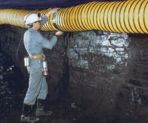Overview
Industrial mining negative pressure ventilation hoses are the most common ventilation ducts in mines and tunnels. They deliver fresh air deep underground. During mining operations, due to factors such as depth, mechanical exhaust, and blasting, underground air can easily accumulate dust, harmful gases (such as methane), and heat, posing a serious threat to the health and safety of workers and posing a significant safety hazard. The core mission of our negative pressure ventilation hoses is to work in conjunction with the main ventilation system to efficiently and reliably extract this polluted air while simultaneously directing fresh air into the working surface, creating a stable and safe air circulation system. This fundamentally improves the underground environment and ensures smooth production operations.
"Negative pressure" refers to the pressure within the duct being lower than the external ambient pressure, creating a "suction force." Our ducts are specifically designed and manufactured to withstand this suction force, ensuring they remain unobstructed and maintain efficient ventilation, unlike standard pipes, during high-pressure extraction.
Application Scenarios
Underground mining operations such as coal and metal mines: Provide continuous fresh airflow for excavation and mining faces.
Railway, highway, and water conservancy tunnel construction: Solve ventilation challenges in long tunnel construction.
Underground caverns and civil air defense projects: Used for daily ventilation or emergency ventilation.
Disaster emergency rescue: For example, after a mine accident, rapid ventilation system establishment is required to dilute toxic and hazardous gases.
Interior construction of large buildings: Used to remove welding fumes and dust.
Purchasing Recommendations
When selecting collapsible ducting for mining and tunnels, please pay attention to the following:
Material and Certification: Select products with the mining product safety mark to ensure they meet flame retardant and antistatic standards.
Diameter and Length: Select the appropriate duct diameter (e.g., φ400mm, φ600mm, φ800mm, φ1000mm, etc.) and single-section length based on the required air volume and ventilation distance. Negative pressure resistance: Based on the fan power and duct length, select a product that can withstand the corresponding negative pressure without deformation.
Wear layer thickness: The thicker the outer layer, the better the wear resistance and the longer the service life.


